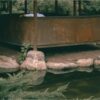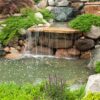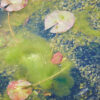Keeping ponds clean is the number one complaint of pond keepers. Keeping a pond with all its green glory can be frustrating for pond keepers, causing their simple pleasures of keeping fish and plants to seem like chores. Aside from obscuring fish and depleting oxygen, algae cause other non-life-threatening challenges. With a few simple steps, you can see your water garden for what it is-a beautiful, unobstructed place of tranquility.
Even the most diligent pond specialist will face algae growth at some point. Although algae doesn’t always look appealing, they provide a valuable service to aquariums and ponds, such as purifying the water and removing pollutants. In a mature aquarium, some algae growth is normal, but excessive growth can indicate a problem with water quality and/or improper maintenance habits. Algae growth occurs by a variety of factors, and you can get rid of it in a variety of ways. The key to controlling and preventing algae growth is understanding what causes it.
Have you ever wondered if plants help reduce algae? You have come to the right place.
We will discuss How to reduce algae in your and the best pond plants you should have in it.
Let’s get started.
Is plant life effective at reducing algae?
Your pond will be less algae-filled with live plants.
They do this by starving algae of light and nutrients, thereby restricting their growth.
Algae reduction by plants: how does it work?
Light and nutrients are also necessary for algae to grow.
Keeping live plants in your house will make the plants compete with algae for nutrients and light.
In general, most of the nutrients are absorbed by the plants and the light is utilized. Having less light and nutrients will limit algae’s growth.
Plants will suffer if they are unable to absorb nutrients quickly, as algae will then overpopulate the tank with nutrients.
What are the best pond plants for reducing algae?
Plants that grow fast tend to reduce algae growth.
Nutrients are necessary for fast-growing plants. Because of these quick growth rates, they will be able to absorb nutrients fairly quickly.
In this way, algae will not be able to obtain nutrients, helping to reduce algae growth.
In this section, I will discuss some fast-growing plants that are good for reducing algae.
1. Amazon Sword
Requirements for lighting
Under moderate lighting conditions, Amazon sword performs well.
If you are using fluorescent light, then you should provide at least 2-3 Watts of light per gallon. If you are using LED light, you should use 35 to 50 micromoles.
At least 11 to 12 hours of light should be present throughout the day.
It is also important to make sure that the lighting is not too bright. Alternatively, give Amazon sword more sun, i.e. 12 hours or more a day, to prevent algae growth.
The best place to keep an Amazon sword
Plants growing in the Amazon region are called Amazon swords. Therefore, ideally you want it to be in the background of your pond.
Requirements for the substrate
Your pond can be planted with Amazon sword on any substrate you like.
You’ll need a substrate that is at least 2.5 inches thick. As a pond plant that feeds from roots. The root structure that it builds requires space in the substrate since it creates a complex root shape.
Requirements for fertilization
Amazon swords are pretty hardy plants. Aside from this, there is no need to add extra fertilizer.
For faster growth, it is recommended that fertilizers be added on a regular basis.
Fertilizers can be supplemental in liquid or root tab form.
2. Dwarf Sagittaria
Dwarf Sagittarias grow quickly. The plant also produces beautiful flowers.
This will starve algae of nutrients and limit their growth, so you will get an immediate increase in your water quality.
It is very easy to keep dwarf Sagittaria in your aquarium because it is highly adaptable to many water parameters.
Light requirements
Sagittaria dwarf isn’t picky about the light it receives.
When lit moderately, it does well.
As a result, fluorescent lighting should provide about 2 to 3 Watts per gallon. If you are using LEDs, you should use light between 35 and 50 micromoles.
The best place to keep dwarf sagittarias
A dwarf Sagittaria plant is generally used for carpeting. It should be planted in the midground or foreground of your arrangement.
What the dwarf Sagittaria needs in terms of substrate
Sagittaria dwarfs are very hardy plants that can be grown in any medium.
You will probably see a faster rate of growth if you keep it in a nutrient-rich medium or in a nutrient-rich soil medium.
Fertilization requirements
Fertilizer requirements for dwarf Sagittaria are quite high.
Fertilizer is not necessary for its growth.
5. Water lettuce
Plants that float on the water are called water lettuces.
Your tank will be starved of nutrients due to its growth, decreasing algae’s nutrition.
Because it requires humid conditions, this plant can be a bit trickier to keep.
When provided with the right conditions, however, it will soon overtake your tank.
Light requirements
Light should be provided for water lettuce under medium conditions.
Two to three Watts per gallon are recommended for fluorescent lighting.
LEDs should provide between 35 and 50 micromoles of light if you are using them.
The best place to store water lettuce
An aquatic plant, water lettuce floats on the surface of the water. It should therefore float on the water’s surface.
Substrate requirements
Due to its floating nature, water lettuce does not need any substrate to grow.
Fertilization requirements
There is no need to fertilize water lettuce. Nutrients are needed for its growth.
Here are some tips to keep your aquarium clear of algae
Keeping pond plants is one way to reduce algae in your aquarium, but there are also several other methods.
1. Control lighting
Uncontrolled lighting is a common cause of algae growth in ponds.
In the first place, you should avoid building the pond in direct sunlight.
As a result, your pond may grow algae.
Make sure you are not keeping the lights on for more than 10 hours if you are using LED or fluorescent lights.
Providing consistent lighting to plants manually can be extremely challenging.
Using a timer is the best solution. You can set the time when the light should be turned on or off.
Plants will receive consistent light this way and algae will be controlled.
2. Control feeding
Algae can also grow due to overfeeding.
The fish always seem hungry, and beginners tend to overfeed their fish.
The problem is that leftover fish food contains phosphate, and this can cause brown diatom algae if you overfeed your fish.
You can avoid overfeeding your fish by feeding them little by little over a period of 5 minutes.
It is overfeeding if most of the food hasn’t been consumed by the fish.
As a result, you should limit food intake in this situation.










